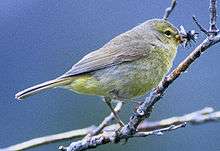Orange-crowned warbler
| Orange-crowned warbler | |
|---|---|
 | |
| Scientific classification | |
| Kingdom: | Animalia |
| Phylum: | Chordata |
| Class: | Aves |
| Order: | Passeriformes |
| Family: | Parulidae |
| Genus: | Oreothlypis |
| Species: | O. celata |
| Binomial name | |
| Oreothlypis celata (Say, 1823) | |
 | |
| Range of O. celata Breeding range Year-round range Wintering range | |
| Synonyms | |
|
Helmintophila celata | |
_crown_visible.jpg)
The orange-crowned warbler (Oreothlypis celata) is a small songbird of the New World warbler family.
Description

These birds are distinguished by their lack of wing bars, streaking on the underparts, strong face marking or bright colouring, resembling a fall Tennessee warbler and a black-throated blue warbler, both of which are also members of the New World warbler family. The orange patch on the crown is usually not visible. They have olive-grey upperparts, yellowish underparts with faint streaking and a thin pointed bill. They have a faint line over their eyes and a faint broken eye ring. Females and immatures are duller in colour than males. Western birds are yellower than eastern birds.
| Standard Measurements[2][3] | |
|---|---|
| length | 4.8–5.3 in (120–130 mm) |
| weight | 9 g (0.32 oz) |
| wingspan | 7.25 in (184 mm) |
| wing | 56.9–62.5 mm (2.24–2.46 in) |
| tail | 46–51.5 mm (1.81–2.03 in) |
| culmen | 10–11.2 mm (0.39–0.44 in) |
| tarsus | 16.5–18.5 mm (0.65–0.73 in) |
Life history
Their breeding habitat is open shrubby areas across Canada, Alaska and the western United States. The nest is a small open cup well-concealed on the ground under vegetation or low in shrubs. The female builds the nest; both parents feed the young.
These birds migrate to the southern United States and south to Central America.
They forage actively in low shrubs, flying from perch to perch, sometimes hovering. These birds eat insects, berries and nectar.
Four to six eggs are laid in a nest on the ground or in a low bush.[2]
The song of this bird is a trill, descending in pitch and volume. The call is a high chip.
References
- ↑ BirdLife International (2012). "Vermivora celata". IUCN Red List of Threatened Species. Version 2014.2. International Union for Conservation of Nature. Retrieved 4 November 2014.
- 1 2 Godfrey, W. Earl (1966). The Birds of Canada. Ottawa: National Museum of Canada. p. 323.
- ↑ Sibley, David Allen (2000). The Sibley Guide to Birds. New York: Knopf. p. 427. ISBN 0-679-45122-6.
- Peluc, S.I.; Sillett, T.S.; Rotenberry, J.T.; Ghalambor, C.K. (2008). "Adaptive plasticity in nest site selection in response to increased predation risk". Behavioral Ecology 19: 830–835. doi:10.1093/beheco/arn033.
External links
| Wikimedia Commons has media related to Leiothlypis celata. |
| Wikispecies has information related to: Leiothlypis celata |
- Orange-crowned warbler - Island Misfits at Smithsonian Migratory Bird Center
- Orange-crowned warbler species account - Cornell Lab of Ornithology
- Orange-crowned warbler - Vermivora celata - USGS Patuxent Bird Identification InfoCenter
- BirdLife species factsheet for Vermivora celata
- Oreothlypis celata on Avibase
- Orange-crowned warbler videos, photos, and sounds at the Internet Bird Collection
- Orange-crowned warbler photo gallery at VIREO (Drexel University)
- Audio recordings of Orange-crowned warbler on Xeno-canto.
